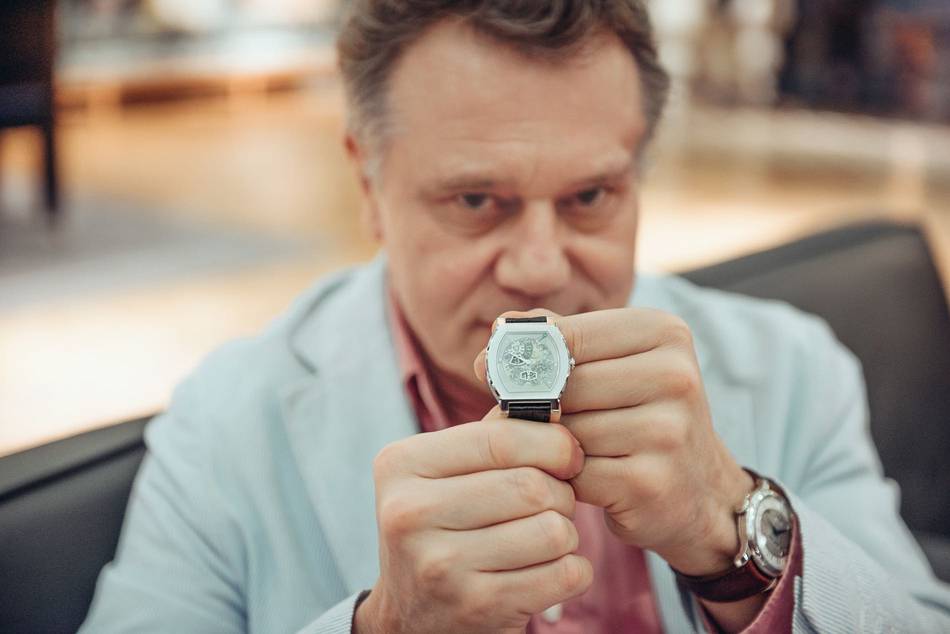Text by Kien Lee | Photos by Amanda Wong
Widely regarded as one of the greatest watchmakers of our modern times, François-Paul Journe graduated from the Paris School of Watchmaking, having started his studies in the same field in Marseilles, in the year 1976, more than forty years ago.
But he didn't know watchmaking was his calling when he started his studies, and didn't quite have it all that easy when he joined the industry.
Journe started building his first watch as a 20-year-old, and completed it as a 25-year-old in 1983. By the time he did, the Swiss watch industry was at its lowest point, having been pummeled by the emerging quartz technology that seemingly harkened batteries replacing mechanical springs as a power source, in the 1970s.
But he eked out a living working in Geneva for his uncle who repaired vintage clocks and watches, and he persisted, and he flourished.
To date, Journe's achievements include seven distinctions at the Grand Prix d'Horlogerie of Geneva, the highest accolades within the watchmaking industry, and on three occasions he was bestowed the ultimate distinction of the Golden Hand "Aiguille d’Or." The watchmaker was also decorated with the title of "Chevalier des Arts et des Lettres" by the French Minister of Culture.
His timepieces come with the motto "Invenit et Fecit" which in Latin translates to "[He] invented it and made it". This tagline serves as an implicit declaration that each exclusive movement has been entirely invented, constructed, and assembled in the Geneva workshops.
With a limited production of less than 900 timepieces per year, the F.P. Journe Manufacture established in 1999 is the epitome of artisanship in the purest form and has led the field with unique aesthetics and ground-breaking mechanical breakthroughs which includethe outstanding Grand Sonnerie, the ultra slim Répétition Souveraine, the emblematic Chronomètre à Résonance or Chronomètre Optimum, to the amazing Octa automatic caliber with a 5 days power reserv, and finally on occasion of his visit to Singapore this time round, the Vagabondage III with jumping digital seconds as the newly-unveiled innovation.
Hosted by The Hour Glass, which in January last year formed an exclusive partnership with F.P. Journe marking the return of the label to Singapore after an absence of six years, we speak to the enigmatic founder.

When you first started learning about watchmaking, did you know back then you were going to be so good at what you are going to do?
I didn’t know at the time. But I had a lot of pleasure (learning) and when I started to make (watches), everything was easy. As soon as you love something, you can learn much quicker and do something much better.
So how did your career as a watchmaker start?
At the time, the watchmaking school was not about how to make watches, but how to repair clocks, then watches.
At the age of 20 in the year 1977, I decided to make my own watch and it was a pocket watch with tourbillon. I was working in my free time, on the weekends and it took me five years.
After the watch was completed, customers started asking if I could make one for them and then the second, and the third and it’s continued to today.
As we get to the thirtieth anniversary of F.P. Journe, where do see your company in the next two years? Is it a milestone?
The next two years is already done! All the novelties and ideas are in the pipeline. In fact, the next five or six years, everything is already planned. This is unlike other brands which have a lot of difficulty presenting something new.
Besides each novelty, is there a larger dream for F.P. Journe?
The last twenty years, more or less, I have already achieved what I wanted to do. Now, the only thing to do, is to make my ideas come true now that I have the tools to do so — from retailer network to manufacture.
Maybe to be as famous as Coca-Cola! Everyone knows Coca-Cola, and I hope everyone knows F.P. Journe. But not to increase in production of 900 pieces a year!

You're generally viewed as one of the greatest watchmakers of all time. Does that perception of you add any pressure, affect you as you create something?
No. I listen to feedback all the time and retain what I need to keep. And then I start to work on my watches.
Is there a typical F.P. Journe collector?
I know more or less all of my collectors. Not all, but every time they assemble together, they have only one thing in common — an F.P. Journe.
A lot of them have followed me since the beginning.
Just like the Vagabondage, they bought the first one 14 years ago. The second one, 7 years ago, and now, the third one this year.
Tell us about the origin of your motto "Invernit et Fecit," which is seen prominently on all your watches.
In the past, part of the motto ("fecit", meaning 'created by') was already used for sculpture artists and painters. In the late 1700s, it was used in the watchmaking (clock) business.
Then in the early 1900s, there were not many watchmakers producing their own movements. There were 4 companies making movements for everyone. So to differentiate ourselves from the others, where we are making our own movements, we have added "Invernit" ('Invent') to our motto.
I would not put my name (on the watch) if it wasn't entirely my own creation.
Today, you're still heavily involved in the process.
Yes, it's my job!
So you must hate leaving the workshop to come out and do media junkets like this one!
Yes! (chuckles)
Something funny and interesting about interviews though is that when people ask me about something I said, it refreshes my memory about things that are still in my mind, but I don't think about them.

What do you see F.P. Journe's role in the larger watch industry?
Of course, today, the market has slowed down. But we are not so affected. We are making art, we are making a small quantity of watches. We are not a big brand that has to make big quantities to get results. We are very small, we make unique pieces and we will always have a market.
But to make a watch a piece of art, you have to be independent.
To explain a little bit more. Until today, F.P. Journe has in the market around 12,000 watches. That’s the same production as two years for A. Lange & Sohne, two weeks for Patek Philippe! Abraham Breguet made half this quantity of watches in his whole life. We are closer to Breguet, than many of the other independent brands today. We remain niche.
Breguet had the same opportunities, with technologies back then, to make more, but he didn’t. We are the same today.

What advice do you have for someone entering the luxury business?
If you don't bring something new in the luxury sector, you don't have any chance. You cannot just copy what someone else is doing. You have to bring a fresh air to compete with the bigger companies.
If not, it's better to provide services, and not produce watches.



















